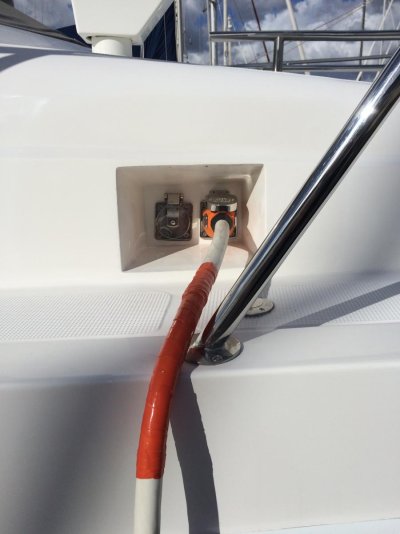Full disclosure: I am Marine Electrician that is also a dealer for SmartPlug.
Regarding a marina only permitting UL listed shore power equipment:
The marina owner can require anything that they want; e.g., only white shore power cords or only green ⅝"double braid dock lines. I have no argument with that.
Because it has been ubiquitous for decades, many professionals and laypeople believe that the only certification authority is Underwriters Laboratories. The process of UL listing is difficult to understand by the layperson, very expensive to achieve by a new manufacturer and, IMHO, is not the "gold standard" that it was in the past.
Other independent, third party testing and certification laboratories have come on line, primarily as competition to UL.
The standards writing organizations such as National Fire Protection Association (National Electrical Code), the American Boat and Yacht Council; ISO do not usually call out a specific certification agency but will generally require certification by a third party. Here are some examples:
NFPA
NFPA 303, “Fire Protection Standard for Marinas and Boatyards”:
5.2 Listed or Labeled. All electrical materials, devices, appliances, fittings, and other equipment shall be listed or labeled by a qualified testing agency and shall be installed and connected in accordance with listing requirements and/or manufacturer’s instructions.
NFPA 70 (National Electrical Code); 555.19(A)(4)(a)
Receptacles rated 30 amperes and 50 amperes shall be of the locking and grounding type.
ISO
ISO 13297 3.14
shore power appliance inlet
fitting designed for mounting on a craft, of a shrouded male type, to connect to the female connector on the craft end of the shore power cable in order to make the electrical connection for transmission of electrical energy
ABYC
ABYC E-11 Figure 12
Shows the standard NEMA configurations for shore power inlets and cables
ABYC E-11 Figure 13
Shows the UL 1686 configurations for pin and sleeve shore power inlets and cables
Regarding the shore power inlet, ABYC E-11.4.29
Shore Power Inlet -the fitting designed for mounting on the boat, of a reverse service type, requiring a female connector on the shore power cable in order to make the electrical connection
and;
11.6.2.2.1.3 The shore power cable shall be flexible cord with the minimum properties of Type SOW, STW, STOW, SEOW, or STOOW, and shall be suitable for outdoor use. The shore connection end of this cable shall be fitted with a locking and grounding type plug with the required number of poles and shall comply with Article 555 of the National Electrical Code (see FIGURE 12 and TABLE VII-A).
EXCEPTION: Pin and sleeve devices in accordance with FIGURE 13.
Note that the SmartPlug configuration is not included in Figures 12 or 13 because the SmartPlug design is patented and it is the ABYC position that patented equipment will not be included in any of their standards.
And finally (is this horse dead yet?), OSHA requires many types of equipment; e.g. shore power cords and inlets, to be tested and certified/listed by a Nationally Recognized Testing Laboratory (NRTL) such as Underwriters Laboratories (UL). (Emphasis added.). The NRTL that has tested and certified the SmartPlug line is Intertek Testing Services NA (formerly ETL).
So, the marina may require all anchors must be chrome plated CQRs, but requiring that shore power cables and the boat inlets must be UL rated is simply not technically sound reasoning.



